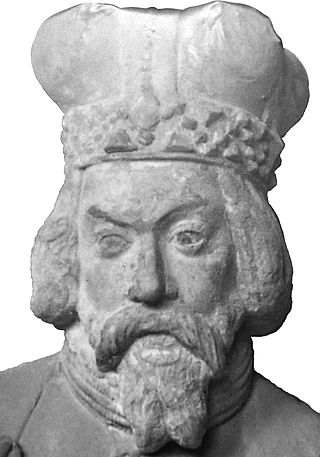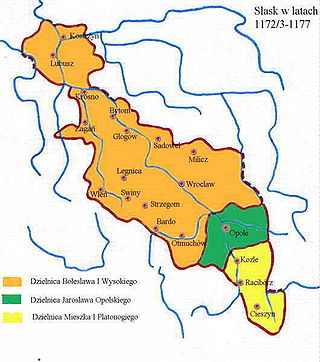
The Duchy of Silesia with its capital at Wrocław was a medieval duchy located in the historic Silesian region of Poland. Soon after it was formed under the Piast dynasty in 1138, it fragmented into various Silesian duchies. In 1327, the remaining Duchy of Wrocław as well as most other duchies ruled by the Silesian Piasts passed to the Kingdom of Bohemia as Duchies of Silesia. The acquisition was completed when King Casimir III the Great of Poland renounced his rights to Silesia in the 1335 Treaty of Trentschin.
Bolko II the Small, was the last independent Duke of the Piast dynasty in Silesia. He was Duke of Świdnica from 1326, Duke of Jawor and Lwówek from 1346, Duke of Lusatia from 1364, Duke over half of Brzeg and Oława from 1358, Duke of Siewierz from 1359, and Duke over half of Głogów and Ścinawa from 1361.

The Duchies of Silesia were the more than twenty divisions of the region of Silesia formed between the 12th and 14th centuries by the breakup of the Duchy of Silesia, then part of the Kingdom of Poland. In 1335, the duchies were ceded to the Kingdom of Bohemia under the Treaty of Trentschin. Thereafter until 1742, Silesia was one of the Bohemian crown lands and lay within the Holy Roman Empire. Most of Silesia was annexed by the King of Prussia under the Treaty of Berlin in 1742. Only the Duchy of Teschen, the Duchy of Troppau and the Duchy of Nysa remained under the control of the Bohemian crown and as such were known as the Duchy of Upper and Lower Silesia until 1918.

The Duchy of Siewierz was a Silesian duchy with its capital in Siewierz. The area was part of the original Duchy of Silesia established after the death of Duke Bolesław III Wrymouth in 1138 during the times of the fragmentation of Poland.

The Duchy of Bytom or Duchy of Beuthen was one of many Silesian duchies. It was established in Upper Silesia about 1281 during the division of the Duchy of Opole and Racibórz among the sons of Duke Władysław Opolski. The duchy's capital was Bytom (Beuthen), formerly part of Lesser Poland until in 1177 the Polish High Duke Casimir II the Just had attached it to the Silesian Duchy of Racibórz.

The Silesian Piasts were the elder of four lines of the Polish Piast dynasty beginning with Władysław II the Exile (1105–1159), eldest son of Duke Bolesław III of Poland. By Bolesław's testament, Władysław was granted Silesia as his hereditary province and also the Lesser Polish Seniorate Province at Kraków according to the principle of agnatic seniority.

Casimir I of Cieszyn, was Duke of Cieszyn from 1315, Duke of Siewierz from 1337 and Duke of Bytom from 1357.

Przemysław I Noszak, was a Duke of Cieszyn-Bytom-Siewierz from 1358, from 1384 ruler over half of both Głogów and Ścinawa and after 1401 ruler over Toszek.

Bolesław I of Cieszyn was a Duke of half of Bytom and Siewierz from 1405, Duke of Cieszyn and half of both Głogów and Ścinawa from 1410, and Duke of Toszek and Strzelin during 1410–1414.

Bolesław II of Cieszyn , was a Duke of Cieszyn since 1431, ruler over half of Bielsko and Frysztat, and during 1452 sole ruler over one half of Bytom.

Duchy of Racibórz was one of the duchies of Silesia. Its capital was Racibórz in Upper Silesia.

The Treaty of Trentschin was concluded on 24 August 1335 between King Casimir III of Poland and King John of Bohemia as well as his son Margrave Charles IV. The agreement was reached by the agency of Casimir's brother-in-law King Charles I of Hungary and signed at Trencsén Castle in the Kingdom of Hungary. It initiated the transfer of suzerainty over the former Polish province of Silesia to the Kingdom of Bohemia, whereafter the Duchies of Silesia were incorporated into the Bohemian Crown.

Konrad I of Oleśnica was a Duke of Żagań and Ścinawa during 1309–1312, Duke of Oleśnica, Namysłów, Gniezno and Kalisz during 1312–1313, Duke of Kalisz during 1313–1314 (alone), Duke of Namysłów from 1313 (alone) and Duke of Oleśnica from 1321 until his death (alone).

Casimir I of Opole, a member of the Piast dynasty, was a Silesian duke of Opole and Racibórz from 1211 until his death.
Casimir of Bytom was a Duke of Opole during 1282–1284 and Duke of Bytom from 1284 until his death.
Bolko I of Opole, was a Duke of Opole from 1282, Niemodlin and Strzelce Opolskie until his death.

Mieszko of Bytom, was a Duke of Siewierz during 1312–1328, Bishop of Nitra 1328–1334 and Bishop of Veszprém from 1334 to his death.

Bolesław of Bytom was a duke of Koźle from 1347 and Duke of Bytom from 1352 to his death.
Trojden I, was a Polish prince, member of the House of Piast, Duke of Czersk after 1310, ruler over Warsaw and Liw after 1313, regent of Płock during 1336–1340.
Siemowit of Dobrzyń, was a Polish prince member of the House of Piast, Duke of Brześć Kujawski during 1267–1288, Duke of Dobrzyń during 1288–1293, 1295–1303 and 1305–1312, during 1293–1295 in captivity in Lithuania, during 1303–1305 deposed, after 1306 hereditary vassal of the Kingdom of Poland.










